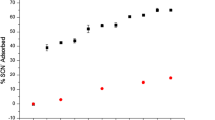Abstract
Field and laboratory data are presented that show a soluble FeS species(FeSaq) exists in sulfidic seawater solutions, and is observedwhen the IAP exceeds the Ksp of amorphous FeS. TheFeSaq yields a discrete signal (double peak) using square-wavevoltammetry and two one-electron waves in sampled DC polarographyexperiments at the Hg electrode. The aqueous FeS species reacts irreversiblyat the electrode as a single FeS subunit and not as a polymeric entity. Thepeak potential of FeSaq occurs at -1.1 V whereas the peakpotential of Fe\((H_2 O)_6^{2 + } \) occurs at-1.45 V; the positive shift for Fe2+ reduction inFeSaq indicates a change in geometry for Fe2+from octahedral to tetrahedral. The kinetics of electron transfer at theelectrode are determined to be similar for both Fe2+ andFeSaq. Molecular orbital energy diagrams, further indicatethat Fe(II) does change from octahedral to tetrahedral geometry in solution.First, Fe(II) exists as octahedralFe\((H_2 O)_6^{2 + } \) in solution whichundergoes a substitution reaction of bisulfide for water. The resultingcomplex, Fe(H2O)5(HS)+, thentransforms to a tetrahedral complex on further addition of sulfide. Thisgeometry change is consistent with the formation of amorphous FeS thatconverts to mackinawite which has tetrahedral Fe(II). The process is entropydriven because of the water loss that occurs. The overall sequence can berepresented as: \(\begin{gathered} 3Fe(H_2 O)_6^{2 + } + 3HS^ - \to 3Fe(H_2 O)_5 (HS)^ + + 3H_2 O \hfill \\ 3Fe(H_2 O)_5 (HS)^ + + 3HS^ - \to Fe_3 S_3 (H_2 O)_6 + 3H_2 S + 9H_2 O \hfill \\ \end{gathered} \) Soluble FeS species are important asreactants in the formation of iron-sulfide minerals including pyrite.
Similar content being viewed by others
References
Bard A.J. and Faulkner L.R. (1980) Electrochemical Methods: Fundamentals and Applications. New York: John Wiley & Sons, Inc. 718 pp.
Berner R.A. (1967) Thermodynamic stability of sedimentary iron sulfides. Amer. J. Sci. 265, 773–785.
Berner R.A. (1970) Sedimentary pyrite formation. Amer. J. Sci. 268, 1–23.
Brendel P.J. and Luther III G.W. (1995) Development of a gold amalgam voltammetric microelectrode for the determination of dissolved Fe2+, Mn2+, O2, and S(-II) in porewaters of marine and freshwater sediments. Environ. Sci. Technol. 29, 751–761.
Buffle J. (1988) Complexation Reactions in Aqueous Systems: An Analytical Approach. New York, NY: Wiley & Sons. 692 pp.
Buffle J., De Vitre R.R., Perret D., and Leppard G.G. (1988) Combining field measurements for speciation in non perturbable water samples. In Metal Speciation: Theory, Analysis, and Application (eds. J. R. Kramer and H. E. Allen), Lewis Publishers Inc., pp. 99–124.
Burgess J. (1988) Ions in Solution: Basic Principles of Chemical Interactions. New York: Ellis Horwood Ltd. 191 pp.
Davison W. (1980) A critical comparison of the measured solubilities of ferrous sulphide in natural waters. Geochim. Cosmochim. Acta 44, 803–808.
Davison, W., Buffle, J., and De Vitre, R.R. (1988) Direct polarographic determination of O2, Fe(II), Mn(II), S(-II) and related species in anoxic waters. Pure and Applied Chemistry 10, 1535–1545.
Davison W. (1991) The solubility of iron sulphides in synthetic and natural waters at ambient temperature. Aquatic Sci. 53, 309–329.
Davison W. and Heaney S. I. (1980) Determination of the solubility of ferrous sulfide in a seasonally anoxic marine basin. Limnol. Oceanogr. 25, 153–156.
Goldhaber M.B. and Kaplan I.R. (1975) Apparent dissociation constants of hydrogen sulfide in chloride solutions. Mar. Chem. 3, 83–104.
Huheey J.E. (1988) Inorganic Chemistry: Principles of Structure and Reactivity. 3rd ed., 968 pp.
Luther III G.W. (1991) Pyrite synthesis via polysulfide compounds. Geochim. Cosmochim. Acta 55, 2839–2849.
Luther III G.W., Rickard D.T., Theberge S.M., and Oldroyd A. (1996) Determination of metal (bi)sulfide stability constants of Mn2+, Fe2+, Co2+, Ni2+, Cu2+, and Zn2+ by voltammetric methods. Environ. Sci. Technol. 30, 671–679.
Meites L. (1965) Polarographic Techniques. New York: Wiley InterScience. 2nd edition, 752 pp.
Myers R.J. (1986) The new low value for the second dissociation constant for H2S. J. Chem. Ed. 63, 687–690.
Rickard D.T. (1975) Kinetics and mechanisms of pyrite formation at low temperatures. Amer. J. Sci. 275, 636–652.
Rickard D.T. (1989). Experimental concentration-time curves for the iron(II) sulphide precipitation process in aqueous solutions and their interpretation. Chem. Geol. 78, 315–324.
Rickard D.T. (1995) Kinetics of FeS precipitation: Part 1. Competing reaction mechanisms. Geochim. Cosmochim. Acta 59, 4367–4379.
Rickard D.T. (1997) Kinetics of pyrite formation by the H2S oxidation of iron(II) monosulfide in aqueous solutions between 25 °C and 125 °C: The rate equation. Geochim. Cosmochim. Acta 61, 115–134.
Rickard D.T. and Luther III G.W. (1997) Kinetics of pyrite formation by the H2S oxidation of iron(II) monosulfide in aqueous solutions between 25 °C and 125 °C: The mechanism. Geochim. Cosmochim. Acta 61, 135–148.
Rickard D., Schoonen M.A.A., and Luther G.W., III. (1995) Chemistry of Iron Sulfides in Sedimentary Environments. In Geochemical Transformations of Sedimentary Sulfur (eds. V. Vairavamurthy and M.A.A. Schoonen); American Chemical Society Symposium Series, Vol. 612, pp. 168–193.
Rieger P.H. (1994) Electrochemistry. New York: Chapman & Hall. 2nd edition 483 pp.
Schoonen M.A.A. and Barnes H.L. (1988) An approximation of the second dissociation constant for H2S. Geochim. Cosmochim. Acta 52, 649–654.
Schoonen M.A.A. and Barnes H.L. (1991) Reactions forming pyrite and marcasite from solution: I. Nucleation of FeS2 below 100 °C. Geochim. Cosmochim. Acta 55, 1495–1504.
Taylor P. (1980) The stereochemistry of iron sulfides-a structural rationale for the crystallization of some metastable phases from aqueous solution. American Mineralogist 65, 1026–1030.
Westall, J.C., Zachary, J.L., Morel, F.M.M., (1976) MINEQL: a computer program for the calculation of chemical equilibrium composition of aqueous systems. Technical Note 18, MIT, Cambridge, MA, 91 pp.
Ueyama N. (1985) Analogues of reduced rubredoxin: Positive shifts of redox potentials of cysteine-containing peptide iron(II) complexes. Inorg. Chem. 24, 2190–2196.
Zhang J. and Millero F.J. (1994) Investigation of metal sulfide complexes in seawater using cathodic stripping square wave voltammetry. Anal. Chim. Acta 284, 497–504.
Author information
Authors and Affiliations
Rights and permissions
About this article
Cite this article
Theberge, S.M., Luther III, G.W. Determination of the Electrochemical Properties of a Soluble Aqueous FeS Species Present in Sulfidic Solutions. Aquatic Geochemistry 3, 191–211 (1997). https://doi.org/10.1023/A:1009648026806
Issue Date:
DOI: https://doi.org/10.1023/A:1009648026806




